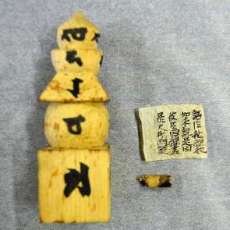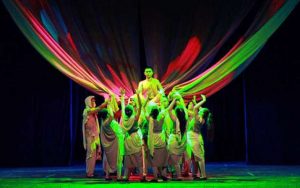The 18th Sakyadhita International Conference was recently held in Seoul under the theme “Living in a Precarious World: Impermanence, Resilience, Awakening.” From on 23–27 June, more than 3,000 Buddhist monastics, laywomen, guests, and dignitaries from South Korea and around the world gathered to share their experiences and research, and to provide support and encouragement for projects and initiatives to improve the lives of Buddhist women. The five-day forum provided an opportunity to touch bases with old friends from around the world, to forge new connections, to learn and to exchange ideas, to inspire and to be inspired.*
BDG was privileged to attend this unique manifestation of the sacred feminine in contemporary Buddhism, and to meet some of the women who are working to shape the face of Buddhism today. Among the many female monastics connected with this remarkable forum is Venerable Dhammananda Bhikkhuni, one of the original founders of Sakyadhita International, and the first fully ordained bhikkhuni from a Theravada lineage in modern Thai history. Although she was unable to attend the conference this year, BDG sat down with Ven. Dhammananda at her monastery in Thailand’s Nakhon Pathom Province to learn about the progress being made on the path of female ordination.
Thailand is a predominantly Buddhist country, with 93.5 per cent of the nation’s population of 69 million people identifying as Buddhists, according to census data for 2018. The Southeast Asian kingdom has some 40,000 Buddhist temples and almost 300,000 monks. However, the country has never officially recognized the full monastic ordination of women. By comparison, the Mahayana Buddhist traditions widely practiced in East Asia have historically been much more accepting of female ordination.
Yet communities of ordained female renunciants do exist and are growing across Thailand, committed to overturning the institutionalized chauvinism that stands in the way of female monasticism. Now numbering around 235 nationwide—a slight decline from pre-COVID numbers—and supported by more progressively minded bhikkhus, they seek to re-establish the fourfold sangha as the optimal holistic and inclusive structure within which all segments of society can study and share the Dhamma.


As a Buddhist scholar, author, and social activist, Ven. Dhammananda Bhikkhuni has been a key figure in the restoration of the female Theravada lineage in Thailand and around the world. Born Chatsumarn Kabilsingh, in 1944, her mother, Voramai Kabilsingh, was the first Thai woman to be fully ordained as a bhikkhuni, albeit in the Mahayana tradition in Taiwan.
After receiving a master’s degree in religion from McCaster University in Canada and a Ph.D. in Buddhism at Magadh University in India, Dr. Chatsumarn taught in the Department of Religion and Philosophy at Thailand’s prestigious Thammasat University in Bangkok, authoring numerous books on contemporary issues in Asian Buddhism.
Dr. Chatsumarn retired from academia in 2000 and received the bodhisattva precepts from Ven. Hsing Yun at Fo Guang Shan in Taiwan. Less than a year later, she took lower ordination in Sri Lanka, receiving the Dhamma name Dhamananda. In 2003, she received full ordination in Sri Lanka, and thus Ven. Dhammananda Bhikkhuni became the first Thai woman to be ordained in a Theravada lineage.
Today, Ven. Dhammananda Bhikkhuni resides at Songdhammakalyani Monastery, founded by her mother, which is currently home to seven bhikkhunis and four newly ordained samaneris. Here she writes and and teaches on issues central to socially engaged Buddhism, such as female empowerment, environmental sustainability, and education.
During the the COVID-19 pandemic and lockdowns in Thailand, which placed huge financial and social stresses on the country’s most vulnerable communities, Songdhammakalyani Monastery was at the forefront of efforts by the country’s monastic sangha to provide humanitarian relief, distributing food and water directly to those worst affected.**
BDG: After all the years of work that you’ve done to reform the female monastic sangha, how widely are female monastics accepted in Thailand today?
Ven. Dhammananda Bhikkhuni: Nowadays, I think we can say that people recgonize bhikkhunis much more readily. You know, when I started out alone, wherever I went people would call out to me and point me toward the male toilet! And when I would explain that I was a female monastic, they would look at me very strangely. Now, of course, there’s no such reaction. In fact, people are much more comfortable making offerings to female monastics, as they do here at our monastery in support of our community.
We may not yet be fully mainstream, but nowadays most people understand that women can be ordained, and they don’t question you quite as hard as they did in the beginning. For example, there’s a small monastery in Nong Khai in northeastern Thailand, near Laos—only two bhikkhunis—but they are very well accepted by the local lay community, who always help to organize various functions at the monastery there. And in the south of Thailand, the female monastics there are very actively involved with local communities—in Songkhla alone we have at least three temples for bhikkhunis.
There are 77 provinces in Thailand, and out of these at least 30 have female monastics.
BDG: Do you receive much support from the male monastic sangha?
VDB: Not that much . . . but we do. According to the Vinaya, we have to receive teachings from male monastics twice a month. And we have senior monks who come here to Songdhammakalyani Monastery to give us instruction.
BDG: And they are very accepting of the bhikkhuni movement?
VDB: According to the Vinaya, it’s their duty! It’s their duty to give us teachings, and then they have to go back to their sangha to report that they have done so. As such, I think it’s fair to say that acceptance is taking place, albeit slowly.

BDG: I suppose I was hoping to hear that more male monastics now recognize the value and importance of the female monastic sangha.
VDB: Well, today, for example, I was checking the handbook for preceptors. Sometimes, when they translate Pali texts, they insert gender issues. For example a verse might say that one who seeks to be ordained must be a human being, sound in body and mind, but sometimes in the translation they add the qualifier “male.”
Because of this, when I teach Pali, I always emphasize how important it is to know Pali so that we can refer to the original source texts. Sometimes when we depend on the translations, we come across these small additions—just one word, but it’s so significant because then it means no women. No women can be ordained. But in the original Pali text, there’s no such thing! So it’s so important to be able to refer to the original texts.
BDG: In the case of the senior administrative levels of Thailand’s monastic sangha, is there still the same kind of resistance or are they starting to evolve in their thinking and attitudes?
VDB: They tend to be quieter nowadays. In the past, those senior positions used to be appointed for life, but now those appointments are only for two years. And even those members of the council of elders are also not permanent. As such, they tend to be quieter about the issue of female ordination.
BDG: So we might say that this is almost a step forward?
VDB: Yes, yes! As more and more women are going forth, they can see that more and more women, once they are ordained, are being recognized and accepted.
And then we have the UTBSI—the United Theravada Bhikkhuni Sangha International—coming together from different countries. Since the UTBSI was formed about two years ago, we have held activities online; we are now teaching the Vinaya online. And this kind of thing, I think, should be appreciated: that the bhikkhunis come and help teach the Vinaya in this way.
Of course, we do receive support. For example, for this year’s Asanha Bucha,*** a day before we enter the rains retreat, we’ve invited some senior monastics: Ven. Ajahn Brahmali from Australia, who accepted right away to be one of the keynote speakers for our celebration. We’ve also invited Ven. Bhikkhuni Tathaloka Mahatheri from the United States to be the second speaker, and Ven. Bhikkhuni Santini Mahatheri from Indonesia to be the third speaker.
So we’re keeping things moving. When the outside world sees the activities that the bhikkhunis are doing at the international level, I think they will appreciate it.


BDG: Can we say, then, that you’re feeling optimistic about the future of the bhikkhuni sangha in Thailand?
VDB: Yes, very much so. Back when I was an academic and working on the bhikkhuni issue, I was very much a lone voice, you know. Nobody was really interested in the bhikkhuni issue. But the fact that I really feel very strongly that this is the missing part, the missing link, in Buddhism, particularly in my country, the effort to bring about recognition is very important.
At the very least, we can be certain that we’re on the right path. We’re on the right track. As Ven. Ajahn Brahm used to say, we are on the right side of history.
Regarding the bhikkhu sangha, I still take part in a dialogue twice a month, and we have two professors who are former monks—one of whom was my student when he was a monk—and they are telling us that the younger generation of monks are much more open-minded about bhikkhunis, which I think is very good news.
BDG: Is there anything else your sangha is working on that you would like people to know about?
VDB: Oh yes, zero waste! In 1985, I began my research on the Buddhist perception of nature. And that’s when I first realized that our Buddhist texts are very rich on how we, as humans, should deal with nature, how to preserve nature. It’s so beautiful, you know: the Buddhist texts are so rich in providing material about how we can take care of nature. Later, after I was ordained, I realized that temples should be centers of learning about this.
And so we offer space for people to come, to sort and clean waste materials, and to learn how to recycle them. Our response to pollution and climate change, you know, it starts with us. It doesn’t start “out there,” it starts with us. So I try to talk about this, and the people who come here regularly they bring their trash, and they can make merit by offering trash!
We would also like to become a center of learning for other temples. If they want to start these kinds of programs, they can do so very easily, and then they can help the people to understand how important it is to start from ourselves and from our own communities.
BDG: Ven. Dhammananda, thank you very much for being so generous with your time.
The Sakyadhita International Association of Buddhist Women is the world’s leading body committed to transforming the lives of women in Buddhist societies, aspiring to empower and unite Buddhist women, promote their welfare, and facilitate their work for the benefit of the Dharma and all sentient beings. “Sakyadhita” means Daughter of Shakya (the clan name of the historical Buddha). Working at the grassroots level, Sakyadhita provides an international network among Buddhist women, promoting research and publications and striving to create equal opportunities for women in all Buddhist traditions.
* Daughters of the Buddha: 18th Sakyadhita Conference in Seoul Celebrates the Sacred Feminine (BDG)
** From Hearts to Hearts: An Interview with Ven. Dhammananda Bhikkhuni (BDG)
*** One of Theravada Buddhism’s most important festivals, celebrating the Buddha’s first sermon at Sarnath.
See more
Songdhammakalyani Monastery
United Theravada Bhikkhuni Sangha International
18th Sakyadhita International Conference: Living in a Precarious World: Impermanence, Resilience, Awakening
Sakyadhita International Association of Buddhist Women
Related features from BDG
Daughters of the Buddha: Buddhism and Film with Ven. Daehae Sunim
Daughters of the Buddha: 18th Sakyadhita Conference in Seoul Celebrates the Sacred Feminine
From Bhutan to Korea: Reflections of a Female Monastic on the Buddhist Path
Buddhistdoor View: Experiencing the Phase Shift – Women in Buddhism Today
Related news reports from BDG
Living in a Precarious World: 18th Sakyadhita Conference Commences in Seoul
BBC Names Dhammananda Bhikkhuni, Thailand’s First Female Monk, among 100 Influential Women of 2019


















